Jesse’s opening keynote address On the Limits to Knowledge of Future Marine Biodiversity from a Scripps Institution of Oceanography conference on that subject appears in The Electronic Journal of Sustainable Development.
News
Revealing tiny food webs
As Bruegel the Elder recognized in 1557, “big fish eat little fish”. Determining exactly what eats what remains a fundamental question in modern ecology and this task is particularly challenging for biologists studying small organisms, which make up the bulk of the biomass in ecosystems. To add interest, a number of these tiny creatures with unknown diets are medically and/or economically important disease vectors.
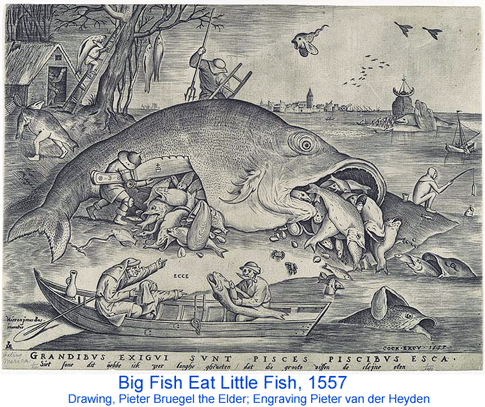
In Mol Ecol Resources May 2008 researchers from University of California, Irvine, Kenya Medical Research Insitute, and Kanazawa University, Japan, apply DNA analysis identify gut contents of larval Anopheles gambiae complex mosquitoes, the major malaria vector in Africa.
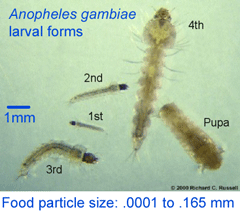 Authors Garros, Ngugi, Githeko, Tuno, and Yan collected anopheline larva near Kisumu in western Kenya, dissected stomach contents of third and fourth instar forms, extracted DNA, and amplified an 800 bp fragment of nuclear 18s rRNA. A separate PCR assay was used to confirm species identity (five were A. gambiae s.s. and 68 were sister species A. arabiensis). According to authors, 18s rRNA was analyzed rather than COI because “more sequences are available [for 18s than for COI] in databases for plants, fungi, and protists”. I note there are now many research groups working on “plants, fungi, and protists” so it should be possible to achieve greater resolution in this sort of study as the DNA barcode libraries are built up.
Authors Garros, Ngugi, Githeko, Tuno, and Yan collected anopheline larva near Kisumu in western Kenya, dissected stomach contents of third and fourth instar forms, extracted DNA, and amplified an 800 bp fragment of nuclear 18s rRNA. A separate PCR assay was used to confirm species identity (five were A. gambiae s.s. and 68 were sister species A. arabiensis). According to authors, 18s rRNA was analyzed rather than COI because “more sequences are available [for 18s than for COI] in databases for plants, fungi, and protists”. I note there are now many research groups working on “plants, fungi, and protists” so it should be possible to achieve greater resolution in this sort of study as the DNA barcode libraries are built up.
The PCR products from gut contents were first screened with a restriction endonuclease known to digest mosquito but not algal 18s. 355 PCR products from eight randomly selected larvae were screened, yielding 14 unique non-mosquito sequences. Best matches in GenBank blast results clustered into 3 main clades: green algae (7), fungi (5), and unknown eukaryotes (2). The authors conclude “the method presented in this study may be a promising tool to investigate natural diets of [anopheline] larvae”. Looking ahead, “such studies will not only improve our understanding of Anopheles larval ecology, but also provide fundamental information to facilitate the develpment of novel larval control tools.”
This study is one demonstration of how routine DNA analysis combined with expanding DNA barcode libraries will help reveal and monitor changes in a multiplicity of tiny food webs. More generally, routine DNA analysis combined with reliable DNA reference libraries opens wide avenues for rapid progress in understanding how the diversity of organisms interact, with benefits to society and science. Continued development of robust, inexpensive methods for analyzing DNA from the various types of biological samples and methods of matching the results to well-curated DNA reference libraries will speed this along.
Finding frogs with DNA
Knowledge of how species are distributed is essential for understanding evolution and ecology, and monitoring enables detecting invasive species and recognizing effects of biological and physical environmental change. That’s easy to say, but many species are small, secretive, or difficult to distinguish from one another, so mapping species distributions requires enormous human effort and ongoing monitoring requires even more. I venture a guess that we have good monitoring for 10,000 or so plant and animal species, mostly large animals and those plants and animals of economic importance, and static distribution maps for about 100,000 species, out of a total of 1.7 million named species and not counting the projected total of 10 million species that might eventually be recognized when surveying biodiversity approaches completion.

Just as high-resolution satellite mapping has surpassed most ground surveys in accuracy, speed, and cost, we need efficient technologies that can help detect and monitor species from environmental samples. In 9 April 2008 Early Online Biol Lett researchers from Universite Joseph Fourier and Universite de Savoie, France, and Universita Milano Bicocca, Italy, apply high-sensitivity DNA analysis to detect presence or absence of American Bullfrog Rana catesbeiana, a globally invasive species. PCR amplification of a diagnostic 79 bp fragment of mitochondrial gene cyt b using species-specific primers (no amplification of samples from the 5 locally native Rana sp). Three 15 mL water samples were collected from each of 9 ponds (surface area 1000-10,000 m^2) in France, including “three ponds where bullfrogs were present at low density (one to two adults seen, no reproduction), three ponds where bullfrogs were present at high density (dozens of adults and thousands of tadpoles), and three ponds where bullfrogs have never been detected.” Each sample was analyzed 3-5 times, giving 9-15 repeats per pond. R. catesbiana DNA was never detected in the ponds with no bullfrogs and was detected in water samples from all three high-density ponds, with most (79%) of replications positive. Bullfrog DNA was also detected in all low-density ponds, although fewer of the replications were postive ( 37%).
Ficetola et al observe “our approach allows the reliable detection of secretive organisms in wetlands without direct observation.” The authors conclude “The ongoing effort to develop DNA barcodes for identifying species from degraded DNA (Hajibabaei et al 2006; Taberlet et al 2007) will make our approach applicable to more and more plant and animals species…These factors will soon make possible the assessment of the current biodiversity of macro-organisms from environmental samples.”
Like satellite mapping 20 years ago, DNA-based environmental monitoring of biodiversity, aided by growing DNA barcode libraries, is set to expand rapidly.
Vote for Encyclopedia of Life Video
The short video about the Encyclopedia of Life has been nominated for a Webby Prize. Please considering voting for it!
In Vitro Protein Production
Andrew Revkin of the New York Times posts a blog Dot Earth: Can people Have Meat and a planet, Too? that refers to our ideas and those of our mentor Cesare Marchetti about in vitro protein (meat) production.
For more details of our thinking, enjoy Because the Brain Does Not Change, Technology Must.
Detecting aliens with DNA
Alien species sometimes damage native landscapes. In Voyage of the Beagle, in entry dated September 19, 1832, Darwin describes the spread of an introduced European thistle Cyanara cardunculus in Banda Oriental, now Uruguay: “very many (probably several hundred) square miles are covered by one mass of these prickly plants, and are impenetrable by man or beast. Over the undulating plains, where these great beds occur, nothing else can live…I doubt whether any case is on record, of an invasion on so grand a scale of one plant over the aborigines.”
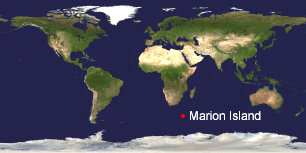 The challenge is to recognize invasive species before they become established. In 11 January 2008 Polar Biology researchers from Stellenbosch University and University of Western Ontario apply DNA barcoding to otherwise unrecognizable moth larvae on sub-Antarctic Marion Island. The indigenous Lepidoptera on Marion Island comprises 2 or 3 flightless moths, and the occassional adult winged moths or butterflies have been assumed to be transients arrived on fresh produce.
The challenge is to recognize invasive species before they become established. In 11 January 2008 Polar Biology researchers from Stellenbosch University and University of Western Ontario apply DNA barcoding to otherwise unrecognizable moth larvae on sub-Antarctic Marion Island. The indigenous Lepidoptera on Marion Island comprises 2 or 3 flightless moths, and the occassional adult winged moths or butterflies have been assumed to be transients arrived on fresh produce.
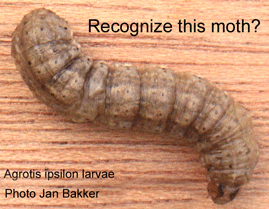 In April 2004, 3 noctuid moth larvae were found in an abandoned Wandering Albatross nest, a common habitat for one of the indigenous moth species. The larvae could be tentatively identified only to genus level and so rearing was attempted, with one larva dying after several months of pupating (as an aside, this is one example of how morphologic identifications can be laborious and/or incomplete, even for experts). The final larva was killed and preserved for DNA study; COI DNA barcode region was amplified using standard Folmer primers. The Marion Island moth larva barcode clustered with the 40 or so Black Cutworm Agrotis ipsilon sequences in BOLD, and was distinct from COI sequences of the other 18 Agrotis species in BOLD. Agrotis ipsilon is a common pest that feeds on a wide variety of plants. The authors conclude that Agrotis ipsilon is an established alien species with the potential to disrupt local ecosystems and that “steps be taken to eradicate the species from Marion Island.”
In April 2004, 3 noctuid moth larvae were found in an abandoned Wandering Albatross nest, a common habitat for one of the indigenous moth species. The larvae could be tentatively identified only to genus level and so rearing was attempted, with one larva dying after several months of pupating (as an aside, this is one example of how morphologic identifications can be laborious and/or incomplete, even for experts). The final larva was killed and preserved for DNA study; COI DNA barcode region was amplified using standard Folmer primers. The Marion Island moth larva barcode clustered with the 40 or so Black Cutworm Agrotis ipsilon sequences in BOLD, and was distinct from COI sequences of the other 18 Agrotis species in BOLD. Agrotis ipsilon is a common pest that feeds on a wide variety of plants. The authors conclude that Agrotis ipsilon is an established alien species with the potential to disrupt local ecosystems and that “steps be taken to eradicate the species from Marion Island.”
It is easy to predict that rapid identification of potential invasive alien species will be a major application of DNA barcoding, with direct economic and ecosystem benefits.
New RU Barcode of Life home page
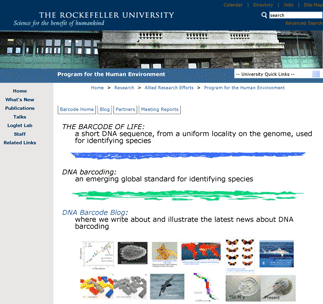 Just posted, a freshly minted home page for Barcode of Life activities at Program for the Human Environment, The Rockefeller University, with expanded links to partners and downloadable pdfs and powerpoint files for illustrated flyers “Top Ten Reasons for Barcoding Life” and “Barcoding Life, Illustrated.” Enjoy!
Just posted, a freshly minted home page for Barcode of Life activities at Program for the Human Environment, The Rockefeller University, with expanded links to partners and downloadable pdfs and powerpoint files for illustrated flyers “Top Ten Reasons for Barcoding Life” and “Barcoding Life, Illustrated.” Enjoy!
.
.
.
.
.
.
TED Conference
The Technology-Entertainment-Design (TED) conference that helped launch the Encyclopedia of Life and connect it with hi-techsters prepared a 4-minute, 13 MB video [download it here] that both reports on progress and shows some nifty features in store for future EOL users.
Routine DNA ID as quality control in ecology and evolutionary biology
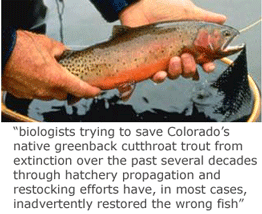 Just as DNA analysis regularly overturns seemingly solid eyewitness identifications in crime investigations, routine DNA analysis can also help biologists avoid blunders. In 28 August 2007 Mol Ecol, researchers from University of Colorado, New Mexico State University, Pisces Molecular, and Brigham Young University report that over 20 years of restocking efforts in western US aimed at restoring native populations of endangered greenback cutthroat trout Oncorhynchus clarkii stomias have mostly been restocking a non-native, non-endangered subspecies, Colorado River cutthroat trout O. c. pleuriticus. They trace the confusion to repeated introductions beginning in the late 1800s of Colorado River cutthroat trout throughout the native range of greenback cutthroat trout. The authors analyzed mitochondrial (COI, ND2) and nuclear (microsatellites, AFLP) DNA from 365 individuals from 15 locations in 3 major river drainage systems in Colorado and surrounding states. Distinct mtDNA lineages corresponding to each subspecies were corroborated by nuclear microsatellite and AFLP data. For another cautionary tale of repeated misidentification of a widely studied organism, see Siddall and colleagues’ entertaining June 2007 Proc R Soc paper scrutinizing commercially available medicinal leeches sold as Hirudo medicinalis.
Just as DNA analysis regularly overturns seemingly solid eyewitness identifications in crime investigations, routine DNA analysis can also help biologists avoid blunders. In 28 August 2007 Mol Ecol, researchers from University of Colorado, New Mexico State University, Pisces Molecular, and Brigham Young University report that over 20 years of restocking efforts in western US aimed at restoring native populations of endangered greenback cutthroat trout Oncorhynchus clarkii stomias have mostly been restocking a non-native, non-endangered subspecies, Colorado River cutthroat trout O. c. pleuriticus. They trace the confusion to repeated introductions beginning in the late 1800s of Colorado River cutthroat trout throughout the native range of greenback cutthroat trout. The authors analyzed mitochondrial (COI, ND2) and nuclear (microsatellites, AFLP) DNA from 365 individuals from 15 locations in 3 major river drainage systems in Colorado and surrounding states. Distinct mtDNA lineages corresponding to each subspecies were corroborated by nuclear microsatellite and AFLP data. For another cautionary tale of repeated misidentification of a widely studied organism, see Siddall and colleagues’ entertaining June 2007 Proc R Soc paper scrutinizing commercially available medicinal leeches sold as Hirudo medicinalis.
How might the future look with routine application of DNA ID as quality control? Incorporating DNA barcode analysis into Tree of Life studies is one useful approach, exemplified by two recent large-scale evolutionary studies published in January and April 2008 Syst Entomol, one on phylogenetic relationships in Saturnid silkmoths, and one on higher-level relationships among 12 families in ‘bombycoid complex’ of Lepidoptera. Both studies analyze COI barcodes of all specimens, “allowing confirmination of their identification for species present in the BOLD reference library and enabling future identifications of organisms whose identity is still pending.”
Interview by Heinz Horeis
German journalist Heinz Horeis who specializes in energy and environment visited the PHE in late 2007. The Swiss weekly news magazine Weltwoche published in German 6 March 2008 a substantial version of Heinz’s longer English conversation with Jesse. A couple of excerpts:
“In twenty years, [renewable] sources will have failed economically, leaving renewable energy to be remembered as the energy equivalent of sub-prime mortgages. “
“But humans are not rational. Why do people buy lottery tickets? They hope for a solution, effectively by magic, as lottery jackpot odds are one in millions. Much of the enthusiasm for renewables is belief in magic. People tire of hearing about problems related to fossil fuels or nuclear power, presented in great detail for 30 years. Anything different sounds better. Humans want to believe. In a profound short story called the Kugelmass Episode by the American humorist Woody Allen, the dissatisfied hero rejects the psychoanalyst who has been trying to adjust Kugelmass to reality and chooses to patronize a magician instead, who works the miracle of transporting Kugelmass into the novel Madame Bovary, with whom Kugelmass then has an affair. Kugelmass, biomass.”